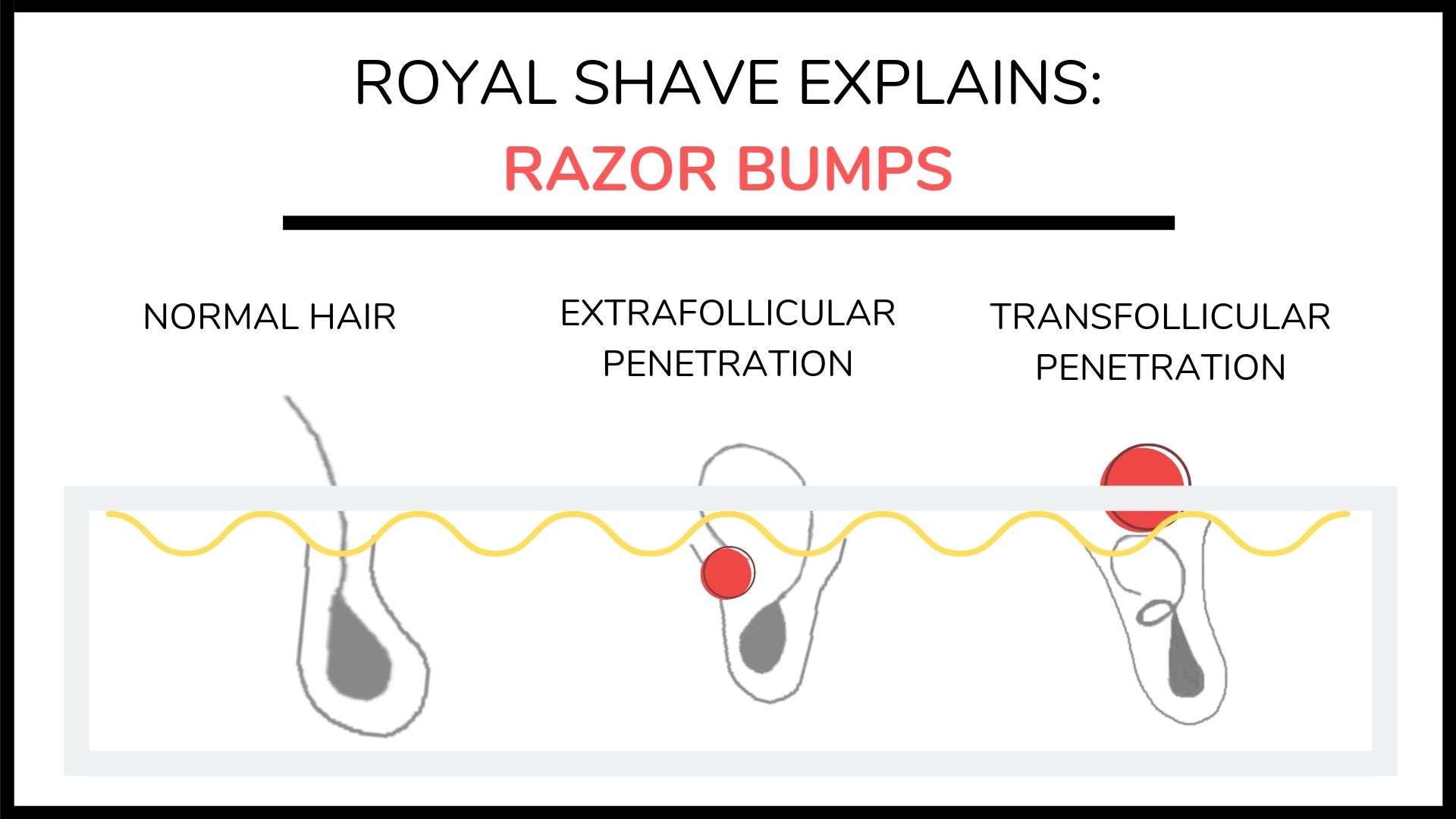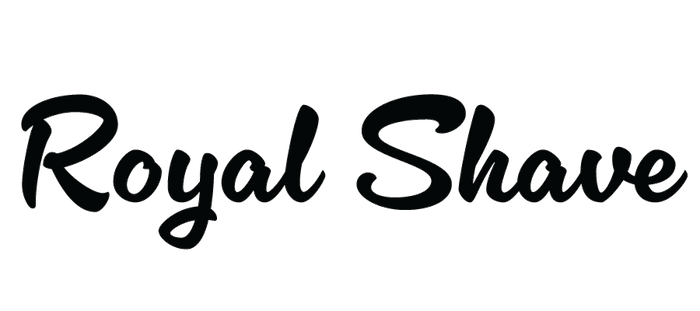When you're growing your beard out, the last thing you want to see is little red bumps poking through your facial hair.
In addition to throwing off your look, razor bumps can be itchy, uncomfortable and even painful. So, why do men develop
razor bumps on their face and how can you get rid of them quickly if it happens to you? Royal Shave breaks down
everything you need to know about razor bumps and shares preventative tips to combat their development in the future.
What are razor bumps?
The scientific name for razor bumps is
Pseudofolliculitis Barbae. This ingrown hair condition
occurs when hair gets
trapped under the skin, causing added pressure and forming razor bumps on the skin's surface. In some cases,
the hair never breaks through the skin's surface, instead curling into itself and continuing to grow downward.
Dermatologists refer to this instance as Transfollicular penetration. On the other hand, facial hair can also break
through the epidermis layer before curling. Razor bumps at this stage often occur when you shave the hair shaft at an
angle. The freshly cut tips are more likely to turn in on themselves and continue growing back into the epidermis layer,
which is deemed Extrafollicular penetration.
Why do bearded men develop razor bumps?
Razor bumps are often a result of both genetic and physical care factors. While certain men and hair types have a
predisposition to razor bumps, poor shaving habits also make the problem worse. Incorrect lathering during shaving can
lead to your razor tugging and pulling and leaving bumps behind. In addition, cutting the hair too close to the root
leaves your sensitive skin exposed and prone to irritation.
Who is more likely to get razor bumps?
Unfortunately, the curling aspects associated
with the development of razor bumps makes men with naturally curly hair predisposed to the condition. With black men
being the most likely to grow curly beards or stubble, dermatologists claim they are at the highest risk of developing
razor bumps and ingrown hair issues. Some dermatologist reports claim black men make up as much as 80 percent of cases.
In addition to curly hair types, men with dry beards are also easy targets because snags are more frequent during
shaving. Similar to curling ribbon at Christmastime, running scissors or a razor along a rough surface causes the hair
to spiral and turn on itself.
What can I do if I develop razor bumps?
If you are visiting this article because razor bumps are already an issue residing on your beard, there are steps you
can take to reduce their appearance and irritating symptoms. First, avoid shaving while your razor bumps are healing.
Cutting the hair shaft while it is irritated can cause pain and lead to infection. Instead, relieve the pressure from
your razor bumps by using a sterile needle to pop the bump and release the trapped hair. Gently wash your face
afterwards to clear out any leftover irritants clogging the area. To speed up the healing process in more serious cases,
a trip to your doctor or dermatologist may be helpful. They can provide creams and antibiotics to provide more targeted
healing and restore your beard's appearance.
Preventative razor bumps tips
While you can't change your genetic predisposition to razor bumps, there are grooming habits you can address to better
your chances of keeping inflammation at bay.
1. Always wash your face and lather before shaving.
Before shaving your beard, it is important to get rid of
the leftover dirt, oils and irritants. Washing your face clears out your pores and provides you with a smooth canvas to
shave on. You can also use a wash cloth to gently exfoliate your face if needed. In addition to washing your face, it is
important to properly lather it with shaving cream. The added moisture barrier avoids awkward tugging or pulling and the
development of uncomfortable razor bumps. Using a
shaving cream designed for sensitive
skin helps ensure your shaving cream isn't the hidden culprit causing
irritation. Typically, sensitive-skin products are free of harmful allergens or parabens that cause inflammatory
reactions.
Shaving oils are also useful for
men who develop razor bumps. The added oil locks in moisture, protecting your face before coming into contact with
clippers or a razor.
2. Use clippers or a single-blade razor to control length.
When you have the choice between using clippers or a razor, clippers are more effective at reducing razor bumps because
you can set the length and maintain an even cut. However, if a razor is your only option, it is best to use a
single-blade razor. While it may seem like you get
a smoother finish with a multi-blade razor, in reality each blade is responsible for a separate layer of your hair. The
first blade collects and pulls the hair up, while the second blade chops through the hair shaft. On straight, soft
beards this offers a sharp clean-shaven look. However, on curly beards, the separated slicing style creates curling and
often leaves razor burn and bumps behind. Therefore, a single-blade razor offers more control and focuses the shaving
process for men prone to these issues naturally.
3. Go with the grain and use gentle strokes.
During the shaving process, your techniques also matter. Shaving with the grain, or in the direction your hair grows,
and using gentle strokes is especially important for men who commonly develop razor bumps. Tugging hairs in the opposite
direction with a heavy hand creates frizz and causes them to continue growing irregularly. Instead, choose a heavier
razor and allow its weight to do most of the work.
4. Re-add moisture after stripping back hair.
After the shaving cream and hairs transfer from
your face to your sink, it's important to reconsider moisture. Despite using shaving creams or oils prior to shaving,
once your clippers or razor makes contact with your face, necessary moisture is stripped away. To keep razor burn's rash
and razor bumps from developing, finish the process by applying a gentle after-shave to your beard area. The
Daimon Barber Cooling Post Shave
Balm uses menthol for a cooling post-shave effect. In conjunction, its
ingredients include a blast of vitamins, antioxidants and nutrients to revive your beard's appearance and skin strength.
5. Shave regularly to avoid curling time.
Finally, it is important to keep up with a regular shaving routine. While you should reduce shaving when razor bumps are
actively present, keeping a regular routine beforehand can actually halt them from showing up in the first place. After
all, when you stick to a shaving routine, there is less time in between each shave for hairs to curl and grow inward.
The ideal time between shaves should be no more than three days. Now that you understand why razor bumps develop, who
they affect the most and how to combat them when they arise, putting your best face forward will be a bit easier.
Following the tips above can help restore your beard appearance and your confidence.







